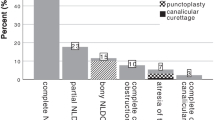Abstract
The purpose of this study was to report various conditions masquerading as congenital nasolacrimal duct obstruction (CNLDO). Retrospective review was designed in a tertiary hospital setting. 92 eyes of 65 consecutive patients were included in this study. All patients presenting with CNLDO symptomatology but where the diagnosis of CNLDO was subsequently ruled out were included in the study. The study patients were recruited from a single surgeon’s (MJA) tertiary eye care practice over a 3-year period from 2011 to 2013. A detailed clinical evaluation and a further lacrimal system evaluation were performed under general anesthesia. The main outcome measure was other lacrimal and nasal conditions masquerading as CNLDO. Average age at presentation was 43.49 ± 31.78 months. All cases had symptoms of either watering or discharge with an increase tear meniscus or abnormal fluorescein dye disappearance test. The commonest masquerades of congenital nasolacrimal duct obstruction include incomplete punctal canalisation (27.2 %), functional epiphora (14.1 %), punctal agenesis (14.1 %), monocanalicular obstructions (10.8 %), and presaccal stenosis (8.7 %). Each masquerade was managed specifically and at the last follow-up of 5.85 ± 10.85 months, 63 % eyes (58/92) had no epiphora and 2.2 % (2/92) eyes had occasional epiphora. Parents of patients with punctal agenesis were counseled for option of conjunctivodacryocystorhinostomy in future. Incomplete punctal canalisation is the commonest masquerade among many conditions that may mimic CNLDO and mandates a careful evaluation. Specific management of each masquerade results in satisfactory outcomes.
Similar content being viewed by others
References
Geurry D, Kendig EL (1948) Congenital impatency on the naso-lacrimal duct. Arch Ophthalmol 39:193–204
Macewen CJ, Young JDH (1991) Epiphora during the first year of life. Eye 5:596–600
Pediatric Eye Disease Investigator Group (2012) Resolution of congenital nasolacrimal duct obstruction with nonsurgical management. Arch Ophthalmol 130:730–734
dela Cuadra-Blanco C, Peces-Peña MD, Jáñez-Escalada L, Mérida-Velasco JR (2006) Morphogenesis of the human excretory lacrimal system. J Anat 209:127–135
Takahashi Y, Matsuda H, Nakamura Y, Kakizaki H (2013) Dacryoendoscopic findings of lacrimal passage with congenital punctal atresia. Orbit 32:338–340
Yuen SJ, Oley C, Sullivan TJ (2004) Lacrimal outflow dysgenesis. Ophthalmology 111:1782–1790
Ali MJ, Mohapatra S, Mulay K, Naik MN, Honavar SG et al (2013) Incomplete punctal canalisation: the external and internal punctal membranes. Outcomes of membranotomy and adjunctive procedures. Br J Ophthalmol 97:92–95
Ali MJ, Naik MN (2013) Canalicular wall dysgenesis: the clinical profile of canalicular hypoplasia and aplasia, associated systemic and lacrimal anomalies, and clinical implications. Ophthalmic Plast Reconstr Surg 29:464–468
Wallace EJ, Cox A, White P, Macewen CJ (2006) Endoscopic-assisted probing for congenital nasolacrimal duct obstruction. Eye 20:998–1003
Chan W, Malhotra R, Kakizaki H, Leibovitch I, Selva D (2012) Perspective: what does the term functional mean in the context of epiphora? Clin Exp Ophthalmol 40:749–754
Acknowledgments
The authors acknowledge the help of Ms Sabera Banu, Librarian, L.V. Prasad Eye Institute, in the literature search, and the provisions of it thereof.
Conflict of interest
The authors declare no conflicts of interests.
Ethical statement
This study has been reviewed by the ethics committee and has been performed in accordance with the ethical standards laid down in the 1964 Declaration of Helsinki. Informed consent was obtained from the parents.
Author information
Authors and Affiliations
Corresponding author
Rights and permissions
About this article
Cite this article
Kamal, S., Ali, M.J., Gupta, A. et al. Lacrimal and nasal masquerades of congenital nasolacrimal duct obstructions: etiology, management, and outcomes. Int Ophthalmol 35, 807–810 (2015). https://doi.org/10.1007/s10792-015-0050-1
Received:
Accepted:
Published:
Issue Date:
DOI: https://doi.org/10.1007/s10792-015-0050-1




